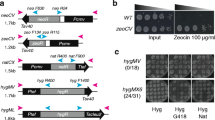Abstract
While the counterselectable Schizosaccharomyces pombe ura4 + gene can be used to prepare a site in the S. pombe genome to receive an unmarked mutant allele (loss of ura4 + confers 5FOA-resistant (5FOAR) growth), the desired unmarked knock-in strains are generally outnumbered by spontaneously arising 5FOAR mutants. Relative to the same approach using the homologous URA3 + gene in Saccharomyces cerevisiae, knock-ins in S. pombe are harder to identify due to a lower efficiency of homologous recombination and a relatively high background of spontaneous 5FOAR colonies. To develop an improved method for identifying cells receiving unmarked mutant alleles, we first determined that 5FOAR strains carry mutations in either of two genes; ura4 + and ura5 +. We then cloned the S. pombe ura5 + orotate phosphoribosyltransferase gene and constructed a 2.1 kb cassette containing ura5 + together with the S. pombe lys7 + gene. Using this doubly marked cassette to disrupt the sck1 + kinase gene, we can distinguish between strains created by homologous knock-in of unmarked wild-type or kinase-dead alleles and spontaneously arising ura4 − and ura5 − mutants by screening 5FOAR colonies for the loss of the lys7 + marker. The utility of this system, especially when the phenotype for the strain carrying the knock-in allele is indistinguishable from that of the disruption strain, is borne out by the fact that ~95% of 5FOAR colonies in our studies arose from background ura4 − and ura5 − mutations.



Similar content being viewed by others
References
Bahler J, Wu JQ, Longtine MS, Shah NG, McKenzie A 3rd, Steever AB, Wach A, Philippsen P, Pringle JR (1998) Heterologous modules for efficient and versatile PCR-based gene targeting in Schizosaccharomyces pombe. Yeast 14(10):943–951
Boeke JD, Trueheart J, Natsoulis G, Fink GR (1987) 5-Fluoroorotic acid as a selective agent in yeast molecular genetics. Methods Enzymol 154:164–175
de Montigny J, Belarbi A, Hubert JC, Lacroute F (1989) Structure and expression of the URA5 gene of Saccharomyces cerevisiae. Mol Gen Genet 215(3):455–462
de Montigny J, Kern L, Hubert JC, Lacroute F (1990) Cloning and sequencing of URA10, a second gene encoding orotate phosphoribosyl transferase in Saccharomyces cerevisiae. Curr Genet 17(2):105–111
Gutz H, Heslot H, Leupold U, Loprieno N (1974) Schizosaccharomyces pombe. In: King RC (ed) Handbook of genetics. Plenum Press, New York
Ivey FD, Hoffman CS (2005) Direct activation of fission yeast adenylate cyclase by the Gpa2 Gα of the glucose signaling pathway. Proc Natl Acad Sci USA 102(17):6108–6113
Ivey FD, Taglia FX, Yang F, Lander MM, Kelly DA, Hoffman CS (2010) Activated alleles of the Schizosaccharomyces pombe gpa2 + Gα gene identify residues involved in GDP-GTP exchange. Eukaryot Cell 9(4):626–633. doi:10.1128/EC.00010-10
Janoo RT, Neely LA, Braun BR, Whitehall SK, Hoffman CS (2001) Transcriptional regulators of the Schizosaccharomyces pombe fbp1 gene include two redundant Tup1p-like corepressors and the CCAAT binding factor activation complex. Genetics 157(3):1205–1215
Jin M, Fujita M, Culley BM, Apolinario E, Yamamoto M, Maundrell K, Hoffman CS (1995) sck1, a high copy number suppressor of defects in the cAMP-dependent protein kinase pathway in fission yeast, encodes a protein homologous to the Saccharomyces cerevisiae SCH9 kinase. Genetics 140(2):457–467
Storici F, Lewis LK, Resnick MA (2001) In vivo site-directed mutagenesis using oligonucleotides. Nat Biotechnol 19(8):773–776. doi:10.1038/90837
Wang L, Kao R, Ivey FD, Hoffman CS (2004) Strategies for gene disruptions and plasmid constructions in fission yeast. Methods 33:199–205
Acknowledgments
This work was supported by a Boston College Undergraduate Research Fellowship to D.K.M. Plasmid pUL57 and strains carrying the lys7-2 and the ura5-14 alleles are readily available upon requests directed to C.S.H.
Author information
Authors and Affiliations
Corresponding author
Additional information
Communicated by P. Sunnerhagen.
Electronic supplementary material
Below is the link to the electronic supplementary material.
Rights and permissions
About this article
Cite this article
Mudge, D.K., Hoffman, C.A., Lubinski, T.J. et al. Use of a ura5 +–lys7 + cassette to construct unmarked gene knock-ins in Schizosaccharomyces pombe . Curr Genet 58, 59–64 (2012). https://doi.org/10.1007/s00294-011-0360-4
Received:
Revised:
Accepted:
Published:
Issue Date:
DOI: https://doi.org/10.1007/s00294-011-0360-4




